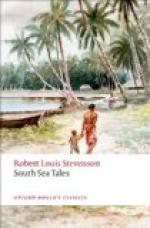so common in the lower animals, and possibly their
chief title to the name. One day, on visiting
my piggery, I was amazed to see Catholicus draw back
from my approach with cries of terror; and if I was
amazed at the change, I was truly embarrassed when
I learnt its reason. One of the pigs had been
that morning killed; Catholicus had seen the murder,
he had discovered he was dwelling in the shambles,
and from that time his confidence and his delight
in life were ended. We still reserved him a long
while, but he could not endure the sight of any two-legged
creature, nor could we, under the circumstances, encounter
his eye without confusion. I have assisted besides,
by the ear, at the act of butchery itself; the victim’s
cries of pain I think I could have borne, but the
execution was mismanaged, and his expression of terror
was contagious: that small heart moved to the
same tune with ours. Upon such ‘dread foundations’
the life of the European reposes, and yet the European
is among the less cruel of races. The paraphernalia
of murder, the preparatory brutalities of his existence,
are all hid away; an extreme sensibility reigns upon
the surface; and ladies will faint at the recital
of one tithe of what they daily expect of their butchers.
Some will be even crying out upon me in their hearts
for the coarseness of this paragraph. And so
with the island cannibals. They were not cruel;
apart from this custom, they are a race of the most
kindly; rightly speaking, to cut a man’s flesh
after he is dead is far less hateful than to oppress
him whilst he lives; and even the victims of their
appetite were gently used in life and suddenly and
painlessly despatched at last. In island circles
of refinement it was doubtless thought bad taste to
expatiate on what was ugly in the practice.
Cannibalism is traced from end to end of the Pacific,
from the Marquesas to New Guinea, from New Zealand
to Hawaii, here in the lively haunt of its exercise,
there by scanty but significant survivals. Hawaii
is the most doubtful. We find cannibalism chronicled
in Hawaii, only in the history of a single war, where
it seems to have been thought exception, as in the
case of mountain outlaws, such as fell by the hand
of Theseus. In Tahiti, a single circumstance
survived, but that appears conclusive. In historic
times, when human oblation was made in the marae, the
eyes of the victim were formally offered to the chief:
a delicacy to the leading guest. All Melanesia
appears tainted. In Micronesia, in the Marshalls,
with which my acquaintance is no more than that of
a tourist, I could find no trace at all; and even
in the Gilbert zone I long looked and asked in vain.
I was told tales indeed of men who had been eaten
in a famine; but these were nothing to my purpose,
for the same thing is done under the same stress by
all kindreds and generations of men. At last,
in some manuscript notes of Dr. Turner’s, which
I was allowed to consult at Malua, I came on one damning




